Traverse of the Black Cuillins
Posted by Jeremy Windsor on Oct 22, 2021
The Cuillin Ridge Traverse is one of Scotland's most famous mountain journeys. In "Classic Rock", Ted Maden wrote, "In a sigmoid sweep of six miles, it encompasses some ten peaks over 3000 feet and several other just below this height. Most sections of the ridge involve scrambling, often of a quite a serious and exposed nature, and several involve rock climbing, two of them of up to Very Difficult standard. The ridge offers magnificent views of sea and loch, and at no point along its length does it drop below 2500 feet. This unique combination of attributes renders the traverse of the Cuillin Ridge one of the most sought after mountaineering expeditions in the British Isles...". We spoke to mountain guide and author Adrian Trendall about the ridge and the extraordinary efforts he’s made to produce a guidebook about it...
Thanks Adrian for talking to me. What do you think it is about the Cuillin Ridge Traverse that appeals to so many?
It's a big challenge but an achievable one. A big tick but one that many can aspire to do. The Cuillin Ridge is the UK's answer to the Alps and is fairly easily accessible to many. The Cuillin is beautiful with jagged mountain peaks rising straight out of the sea.
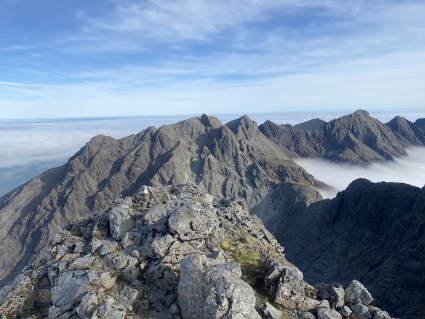
The Cuillin Ridge
Can you put an estimate on how many times you've completed the route? What's been the most memorable?
No idea, to be honest. I've done 4 traverses so far this year and would guess that I've probably done about 50 plus times. Most memorable was with a 70 odd year old client who'd a couple of months previously finished all the Munros. With his wife we ticked all the Cuillin Munros to finish his 33 year epic of Munro Bagging. On the last summit his wife said thank goodness that's over, I never need do anything like that again. The husband just smiled and asked if he could come back and do the Cuillin Ridge. Due to other work commitments I couldn't do it until late autumn and with the short days we planned to do it with two bivis over three days. We finished and it was one of the most amazing I've done and we experienced snow, hail, rain, high winds and even some sunshine!
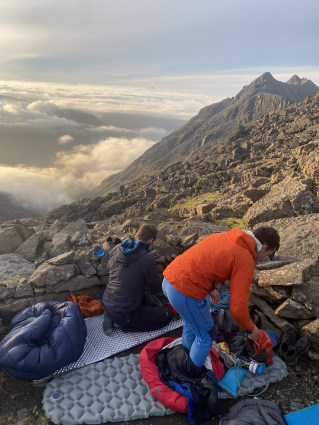
With a copy of Skye's Cuillin Ridge Traverse to help us, James, Noah and I completed the route in June 2021. Taking advantage of the long hours of daylight we made an evening ascent of Gars Bheinn before heading north west on the ridge and eventually bivvying for the night above Coir a'Ghrunnda
Do you have any favourite parts of the traverse?
Favourite bits would include the Inaccessible Pinnacle, An Stac and the south ridge of Sgurr a Ghreadaidh. I guide the In Pinn in it's own right as a Munro a lot but every time it brings a smile to my face. An Stac is often bypassed but that's missing the longest and highest continuous bit of scrambling on the whole ridge. From a distance the south ridge of Ghreadaidh forms an amazing arc and the airy arête between the two summits is pretty special.
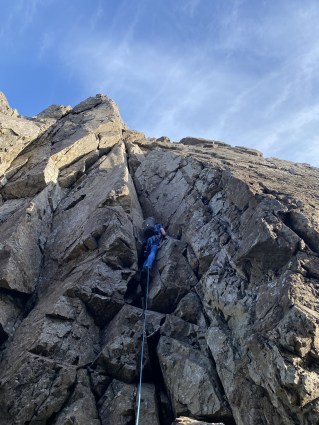
James leading the first pitch of rock climbing on the traverse - TD Gap - it's not particularly difficult but climbing in approach shoes and carrying a rucksack doesn't make it any easier!
It's often said that as many as 9 out of 10 fail to complete the traverse on their first attempt. Why do you think so many people are unsuccessful?
Given the relative low climbing grades, I suspect many people turn up over confident and perhaps with not enough hill fitness for such a challenge. Navigation is very tricky even in half decent conditions. The proximity to the sea and the prevailing maritime climate means things can change swiftly and the weather can be a decisive factor in success or failure. Wet rock, especially basalt slabs such as high on Sgurr Mhic Choinnich, can really slow progress. Conversely, too hot and there can be problems with lack of water and debilitating heat.
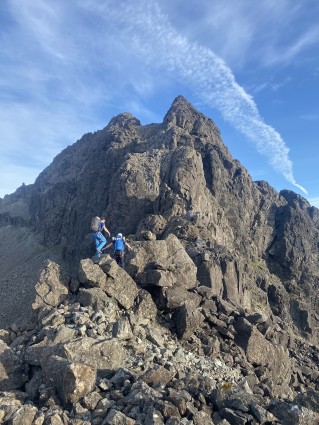
At 6 miles the ridge isn't particularly long - but what takes time is the enormous amounts of vertical ascent and descent that's needed to complete it!
What would you say is the best way to prepare for the Cuillins?
Undoubtedly the best preparation for the Cuillin is visits to the Cuillin to get to know the more tricky sections. Research using guide books, the internet etc and come well prepared. Make sure all your kit is tried and tested; the Cuillin is a harsh environment and no place to be seeing if new gear does or doesn't work. Get slick and quick with your rope work and make sure you have a grade or two in hand for the technical rock climbs. Long hill days carrying the kit you'll be taking on the ridge are best. Perhaps enchainments of multiple long scrambles and easy climbs in Snowdonia or the Lake District.
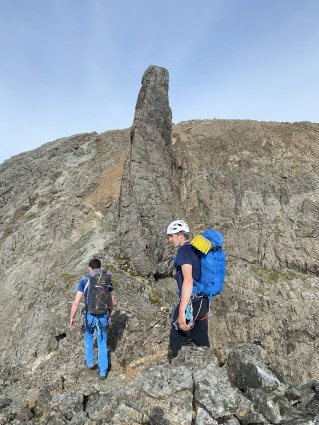
The Inn Pinn marks a point on the ridge where it starts to turn towards the east. It's a mistake to think of it as the half way point - that still lies some way further along the ridge!
I don't think I've come across such detail in a guidebook before - it must have been an enormous undertaking. Can you tell us about what inspired you to write it and some of the challenges that you faced along the way?
I just wanted to produce a book that had all the info I would have liked prior to my first traverse and to have it set out in a linear, geographic fashion with great mapping, detailed photo topos and correlating text route description.
For too long, I think, the Cuillin Ridge has been portrayed as a bit of a black art with much information being not easily available. My idea was to correlate all available info and make it readily available in a format that was user friendly.
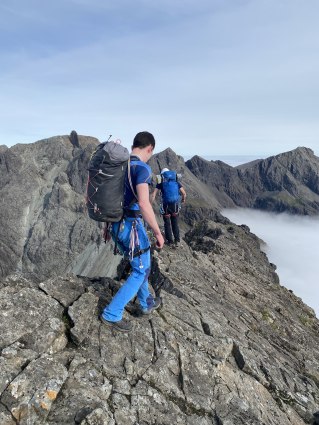
Long stretches of ridge scrambling follow the Inn Pinn. Routefinding here is often difficult and it's where Adrian's guidebook proves invaluable. As fatigue starts to set in it was vital to keep check the images and text. It's so easy to get lost here and lose a great deal of time!
Actually, writing it was fairly easy since my daily guiding work means I know the ridge pretty well and had most of the necessary photos. More challenging was getting the work to fit the Cicerone blue print and style. Being based in Glen Brittle meant it was easy for me to get any extra info/photos Cicerone wanted and I can remember Joe Williams, who edited the book, getting in touch and asking for extra photos of such and such and I'd try and plan my day around that.
The whole process was a real pleasure and pretty much stress free and Cicerone were brilliant to work with on the project. Possibly the biggest challenge was narrowing down the photo selection and having a friendly debate with Cicerone about what to include or omit.
I suspect that the 90% failure rate we discussed earlier has fallen dramatically with the use of your guide. The feedback must have been incredibly positive! Can you share any of it?
Feedback has been truly awesome and it's a real pleasure to meet people in the Cuillin on a daily basis when I'm out guiding. It's been really heartening the number of people who have bought the guide book direct from us and during Covid lockdown it was a bit of a financial lifesaver. Messages and emails with kind comments have been frequent and it's been great to see so much love for a humble guide book.
I wasn't sure how the book would be received so it was a bit of a relief that Simon Richardson gave it such a glowing review on his website,
"All great guidebooks are labours of love, and clearly a huge amount of local knowledge, experience, thought and care have gone into this production. It contains a myriad of detail and information that will greatly assist the completion of the Cuillin Ridge Traverse in both summer and winter. Adrian Trendall and Cicerone should be congratulated for an outstanding publication."
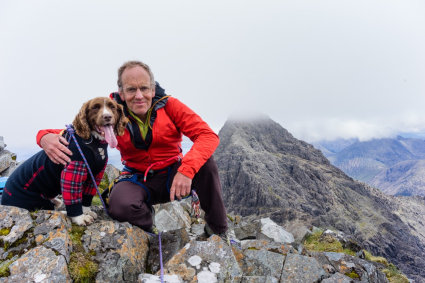
Adrian and "Genghis The Springer" out on the Black Cuillins
Thanks Adrian!
Adrian's guidebook "Skye's Cuillin Ridge Traverse" can be bought here. Don't try the ridge without it!
Finlay Wild is the current record holder for the fastest traverse of the Cuillin Ridge. He'll be talking at the BMMS UCLan Mountain Medicine Winter Webinar next week. Book your place here!
Comments
Leave a comment.
Leave a comment.



 )
)